 Open Access
Open Access
ARTICLE
QIAN LI1,#, SHUNPENG ZHU1,#, MINGXIAN ZHU2, FANG WANG1,*, JINHUA ZHOU1,*
Oncology Research, DOI:10.32604/or.2025.062539
(This article belongs to the Special Issue: Signaling Pathway Crosstalk in Malignant Tumors: Molecular Targets and Combinatorial Therapeutics)
Abstract Objectives: Our previous research demonstrated that SIC-19, an innovative inhibitor of salt-inducible kinase 2 (SIK2), effectively reduces SIK2 protein levels through the ubiquitin-proteasome pathway and exhibits synthetic lethal effects with poly ADP-ribose polymerase (PARP) inhibitors in ovarian cancer. However, the role of SIC-19 in triple-negative breast cancer (TNBC) and pancreatic cancer (PC) remains poorly defined. This study aims to investigate whether SIC-19 combined with PARP inhibitors can induce synthetic lethal effects in TNBC and PC. Methods: Cell lines with high SIK2 expression were identified through Western blot analysis. The combination’s impact was evaluated using Cell… More >
 Open Access
Open Access
ARTICLE
JI ZENG1,2,3,#, XUETENG MENG1,3,#, YUAN ZHANG1,3, JUN LI1, TAOTAO MA1,3,4, CHENG HUANG1,3,*
Oncology Research, DOI:10.32604/or.2025.061978
(This article belongs to the Special Issue: Novel Biomarkers and Treatment Strategies in Solid Tumor Diagnosis, Progression, and Prognosis)
Abstract Background: Renal cell carcinoma (RCC) is a prevalent malignancy characterized by a rising incidence and significant mortality. Interleukins (ILs) are crucial in regulating immune cell trafficking and exhibit anti-tumor properties. However, limited research has explored the expression levels and prognostic significance of interleukins in RCC. Methods: In this comprehensive study, we performed a detailed analysis of interleukins in RCC patients using multiple bioinformatics tools, including Oncomine, UALCAN, GEPIA, Kaplan-Meier plotter, cBioPortal, GeneMANIA, TRRUST, STRING, and Linked Omics. Results: Our analysis demonstrated a significant upregulation in the transcriptional levels of IL4, IL7, IL15, IL16, IL23A, IL26, and… More >
 Open Access
Open Access
ARTICLE
YOUYANG HU1,#, YISHU LUO1,#, TIANYUE XIE1, YUEHUA CHEN1,2, JUN ZHAO1, WEICHAO JI3, ZHIWEI YAN3, SITONG QIU3, KEXIN GAO3, HAIXIA ZHU4, LIMIN MA1,*, QIYOU YIN1,*
Oncology Research, DOI:10.32604/or.2025.060021
(This article belongs to the Special Issue: Novel Biomarkers and Treatment Strategies in Solid Tumor Diagnosis, Progression, and Prognosis)
Abstract Objective: Neuroblastoma (NB) is frequently associated with high-risk pediatric cases that demonstrate limited response to cisplatin, contributing to a poor prognosis. Recent studies have explored the role of tumor cell senescence in increasing sensitivity to this chemotherapy agent. This study aims to identify genes related to cell senescence in children diagnosed with NB, evaluate their influence on cisplatin sensitivity, and investigate potential strategies to enhance the efficacy of chemotherapy. Methods: Gene expression profiles and clinical data were obtained for 498 NB patients from the GEO database (GSE49710). The study focused on identifying genes that were… More >
 Open Access
Open Access
ARTICLE
THAINá RODRIGUES1,2, PATRíCIA CANDIDO1,3, FERES CAMARGO MALUF1, POLIANA ROMãO1, CAROLINA MIE MIOSHI1, VANESSA RIBEIRO GUIMARãES1, JULIANA ALVES DE CAMARGO1, KARINA SERAFIM DA SILVA1,4, GABRIEL ARANTES DOS SANTOS1, IRAN AMORIM SILVA1, KATIA RAMOS MOREIRA LEITE1, WILLIAM C. NAHAS5, SABRINA T. REIS1,3, RUAN PIMENTA1,6, NAYARA IZABEL VIANA1,7,*
Oncology Research, DOI:10.32604/or.2025.055306
Abstract Objectives: Bladder Cancer (BC) is one of the most commonly diagnosed malignancies worldwide, with high rates of mortality and morbidity. It can be classified as non-muscle invasive bladder cancer (NMIBC) or muscle-invasive bladder cancer (MIBC), with radical cystectomy being the treatment for MIBC, which significantly reduces quality of life. MicroRNAs (miRs) act as critical genetic regulators, with both oncogenic and tumor-suppressive roles. MiR-10a is described as a tumor suppressor in various neoplasms, but its role in BC is controversial. This study aims to assess the activity of miR-10a in cellular invasion and proliferation in two… More >
 Open Access
Open Access
ARTICLE
FANGFANG HU1, ZHIBIN BAI2, YANG WANG1, HAODONG TANG3, JIAHUA ZHOU1,*
Oncology Research, DOI:10.32604/or.2025.059631
(This article belongs to the Special Issue: Novel Biomarkers and Treatment Strategies in Solid Tumor Diagnosis, Progression, and Prognosis)
Abstract Background: Kinesin-14 family protein 1 (KIFC1) is abnormally overexpressed in various cancers, and the transcription factor ETS variant 1 (ETV1) is an oncogenic transcription factor in tumors. The potential binding sites on the KIFC1 promoter by ETV1 were observed; however, no evidence supports that ETV1 targets KIFC1. Aims: This study aimed to investigate the relationship between KIFC1 and ETV1, and their effects and mechanisms in pancreatic cancer. Methods: Pan-cancer analysis of KIFC1 expression was performed in GEPIA2 database. KIFC1 expression levels were determined by immunohistochemistry (IHC) in our pancreatic cancer cohort. The correlation between KIFC1… More >
 Open Access
Open Access
REVIEW
YUYU YE, YING LIU*
Oncology Research, DOI:10.32604/or.2025.061857
Abstract Liver cancer is the fifth most common cancer in the world, with China bearing a disproportionate burden of cases. Typically diagnosed at advanced stages, liver cancer often utilizes surgical treatments such as resection, transcatheter hepatic artery chemoembolization (TACE), and radiofrequency ablation. However, advancements in genetic engineering and tumor immunology have unveiled the distinct potential of targeted oncolytic virus therapy. Oncolytic virus, in particular, can selectively destroy tumor cells without harming normal cells, offering a promising avenue for liver cancer treatment through immune system activation, tumor microenvironment modulation, and other mechanisms. This review describes the mechanism More >
 Open Access
Open Access
ARTICLE
KEFAN LIU1, XIAOSONG WANG1, XIN YANG1, BOWEN SHI1, LEI XING2,*, JUNXIA CHEN1,*
Oncology Research, DOI:10.32604/or.2025.061721
(This article belongs to the Special Issue: Novel Biomarkers and Treatment Strategies in Solid Tumor Diagnosis, Progression, and Prognosis)
Abstract Background: Accumulating studies have shown the important role of circular RNAs (circRNAs) in the oncogenesis and metastasis of various cancers. We previously reported that circACTN4 could bind with FUBP1 to promote tumorigenesis and the development of breast cancer (BC) by increasing the expression of MYC. However, its exact molecular mechanism and biological function have not been fully elucidated. Methods: Here, Circular RNA microarray analysis was conducted in 3 pairs of BC and paracancerous tissues. The expression of circACTN4 in BC cells and tissues was detected via reverse transcription‒quantitative PCR (RT‒qPCR). Cell Counting Kit-8 (CCK-8), 5-ethynyl-2-deoxyuridine… More >
Graphic Abstract
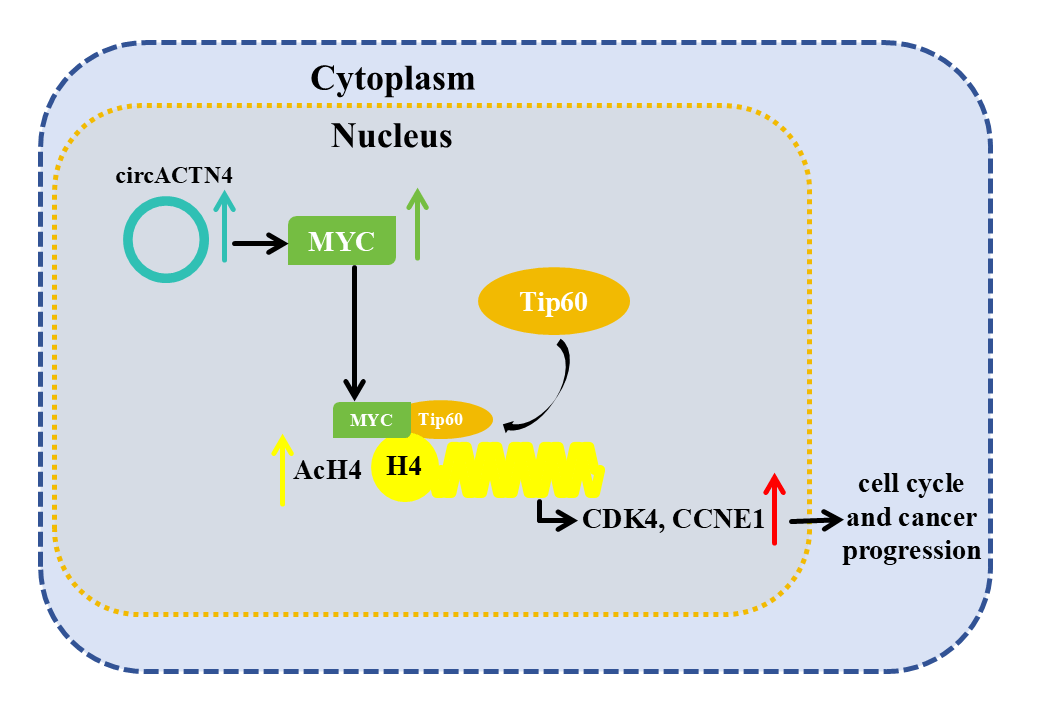
 Open Access
Open Access
ARTICLE
WENZHUO YANG1,#, HAODONG CHEN2,#, ZHILAN ZHANG3, ZHIYONG XIA3, YUANYUAN JIN1,*, ZHAOYONG YANG1,*
Oncology Research, DOI:10.32604/or.2025.059426
(This article belongs to the Special Issue: Novel Targets and Biomarkers in Solid Tumors)
Abstract Background: Human natural killer (NK) cells have attracted widespread attention as a potential adoptive cell therapy (ACT). However, the therapeutic effects of NK cell infusion in patients with solid tumors are limited. There is an urgent need to explore a suitable new treatment plan to overcome weaknesses and support the superior therapeutic activity of NK cells. Methods: In this study, the mechanisms underlying the susceptibility of gastric cancer (GC) cell lines AGS, HGC-27, and NCI-N87 to NK cell-mediated cytotoxicity were explored. Results: Lactic dehydrogenase (LDH) release assays showed that all three GC cell lines were susceptible… More >
 Open Access
Open Access
REVIEW
MOHAMMAD AMIN ELAHI NAJAFI1,2,#, TAKUO MATSUKAWA1,2,#, HIROSHI MIYAMOTO1,2,3,*
Oncology Research, DOI:10.32604/or.2025.062142
Abstract Sex hormones, including androgens and estrogens, are known to have widespread physiological actions beyond the reproductive system via binding to their cognitive receptors, members of the nuclear receptor superfamily that function as ligand-inducible transcription factors. Meanwhile, a growing body of evidence has indicated the involvement of androgen receptor, as well as estrogen receptors such as estrogen receptor-α and estrogen receptor-β, in the pathogenesis and growth of various types of malignancies, including urothelial cancer. Additionally, in bladder cancer, the activity of sex hormone receptors has been implicated in modulating sensitivity to conventional non-surgical therapy. These may More >
 Open Access
Open Access
REVIEW
JIAJIA LV, XIAOYOU ZHONG, LIN WANG, WEIFEI FAN*
Oncology Research, DOI:10.32604/or.2025.060063
(This article belongs to the Special Issue: New Insights in Drug Resistance of Cancer Therapy: A New Wine in an Old Bottle)
Abstract The tumor microenvironment (TME) is a complex and dynamic network comprised of tumor cells, surrounding cellular components, various signaling molecules, and the stroma. Myeloid-derived suppressor cells (MDSCs) are pivotal players in the immunosuppressive landscape of the TME, effectively hindering antitumor immune responses and facilitating tumor progression. Originating from pathologically activated myeloid precursors and relatively immature myeloid cells, MDSCs retain plasticity to further differentiate into other myeloid cells, such as macrophages or dendritic cells, which underpins their heterogeneity and adaptability in response to the TME. In this review, we delve into the plasticity of MDSCs in More >
 Open Access
Open Access
REVIEW
JIANG ZHU*
Oncology Research, DOI:10.32604/or.2025.058957
(This article belongs to the Special Issue: Transcriptome Analysis in Tumor Microenvironment and Tumor Heterogeneity)
Abstract Changes in the intestinal immune micro-environment of the gastrointestinal tract are indispensable in the occurrence and development of gastrointestinal cancer. Tertiary lymphoid structure (TLS) is an immune cell aggregation structure found around gastrointestinal cancer in recent years. More and more research proves that tertiary lymphoid structure plays a key biological role and clinical value in disease progression, patient prognosis, and adjuvant treatment. This review aims to explore the research progress, biological significance, and potential clinical applications of TLSs in gastrointestinal tumors. The formation, development, and interaction of TLSs with tumor microenvironment have been reviewed and More >
 Open Access
Open Access
REVIEW
ASHUTOSH KUMAR MAURYA1, ANJALI SANGEETH1, RABINA PUNATHIL1, R. GRACE RAJI1, V.B. SAMEER KUMAR2,*
Oncology Research, DOI:10.32604/or.2025.055945
(This article belongs to the Special Issue: Unraveling the Mysteries of Metabolic Reprogramming in Cancer: Pathways, Progression, and Precision Therapies)
Abstract Carcinogenesis is a multilevel process characterized by genetic and epigenetic alterations, thus contributing to uncontrolled proliferation that eventually leads to cancer. The process of carcinogenesis involves an intricate dis-orchestration in the expression of both, coding and non-coding sequences and is also dependent on the reprogramming of energy metabolism as both direct and indirect consequence of oncogenic mutations. Dysregulated mitochondrial energetics is an important hallmark of cancer, where cancer cells switch to the glycolytic pathway as an alternate source of energy to support the continuous energy supply needed for their indefinite growth. Even though functional mitochondria… More >
 Open Access
Open Access
REVIEW
GIOVANA GOMES CHAGAS1, RUAN PIMENTA2, NAYARA IZABEL VIANA1,*
Oncology Research, DOI:10.32604/or.2025.055100
Abstract The monoclonal antibodies consist of an innovative form of immunotherapy, capable of defeating several diseases, such as cancer. It is an emergent and important theme, that advances evaluation, challenges, and future perspectives with high relevance to identify gaps in recent studies and to consolidate this general theme in only one research. Its action in Chronic and Acute Lymphoid Leukemia has been evaluated in several clinical trials, which were selected between 2022 and 2023, in order to understand better the monoclonal antibodies that were most studied. The biopharmaceutical compounds Ibrutinib, Obinutuzumab, Rituximab, Venetoclax, and Inotuzumab Ozogamicin… More >
 Open Access
Open Access
ARTICLE
DEXUE FAN1,#, WEI SU2,#, ZHAOWEN BI3, XINXING WANG1, XIANWEN XU1, MINGZE MA4, LICHAO ZHU5, ZHENHAI ZHANG1,3,*, JUNLIN GAO2,*
Oncology Research, DOI:10.32604/or.2025.060407
(This article belongs to the Special Issue: Signaling Pathway Crosstalk in Malignant Tumors: Molecular Targets and Combinatorial Therapeutics)
Abstract Objectives: Apatinib has been reported to be a promising treatment for sorafenib-resistant hepatocellular carcinoma (HCC) patients. However, the underlying mechanism remains ambiguous. The study aimed to explore the efficacy of apatinib in sorafenib-resistant HCC and the underlying mechanism both in vitro and in vivo. Methods: After observing epithelial-mesenchymal transformation (EMT) changes in HepG2 and HepG2/Sorafenib cells, we treated them with varying concentrations of apatinib to assess its impact on sorafenib-resistant HCC. Subsequently, specific inhibitors of c-Jun N-terminal kinase (JNK, SP600125) and extracellular signal-regulated kinase (ERK, PD98059) were introduced to investigate whether apatinib influenced sorafenib-resistant HCC via modulation… More >
 Open Access
Open Access
REVIEW
ABDUR JAMIL1, RIMSHA SIDDIQUE2, FARYAL ALTAF3, DANIYAL WARRAICH4, FAIZAN AHMED5, ZAHEER QURESHI6,*
Oncology Research, DOI:10.32604/or.2025.058790
Abstract Background: Male breast cancer (MBC) is a rare but significant health concern, accounting for less than 1% of all breast cancer cases. Despite its low incidence, it presents unique clinical, genetic, and psychosocial challenges. Genetic predispositions, including BRCA2 mutations and hormonal imbalances, are key factors influencing the development of MBC. However, the rarity of the condition has led to limited research and fewer treatment guidelines specifically for male patients. Methods: A comprehensive literature review was conducted using PubMed, MEDLINE, and Embase databases to identify studies focusing on the epidemiology, risk factors, clinical presentation, diagnosis, treatment,… More >
 Open Access
Open Access
ARTICLE
NURAN BEDOLLA#, HAO WU#, LINYU LIU, XUETING LIU, YANLI REN*
Oncology Research, DOI:10.32604/or.2025.060151
(This article belongs to the Special Issue: Signaling Pathway Crosstalk in Malignant Tumors: Molecular Targets and Combinatorial Therapeutics)
Abstract Background: Gallic acid (GA), a plant-derived polyphenol, possesses diverse biological functions such as reducing inflammation and against tumors. Currently, the influence of GA on the resistance of esophageal squamous cell carcinoma (ESCC) cells to cisplatin (DDP) is not well understood. Methods: Cell counting kit-8 assay examined how GA affected KYSE30 and TE-1 cell viability. 5-Ethynyl-2′-deoxyuridine and TdT-mediated dUTP Nick-End labeling staining detected cell proliferation and apoptosis. Clone formation assay, flow cytometry, Carboxyfluorescein diacetate succinimidyl ester fluorescent probes, and Transwell assay determined cell biological properties, and 2′,7′-Dichlorofluorescin diacetate (DCFH-DA) fluorescent probes detected oxidative stress levels. Signal… More >
Graphic Abstract
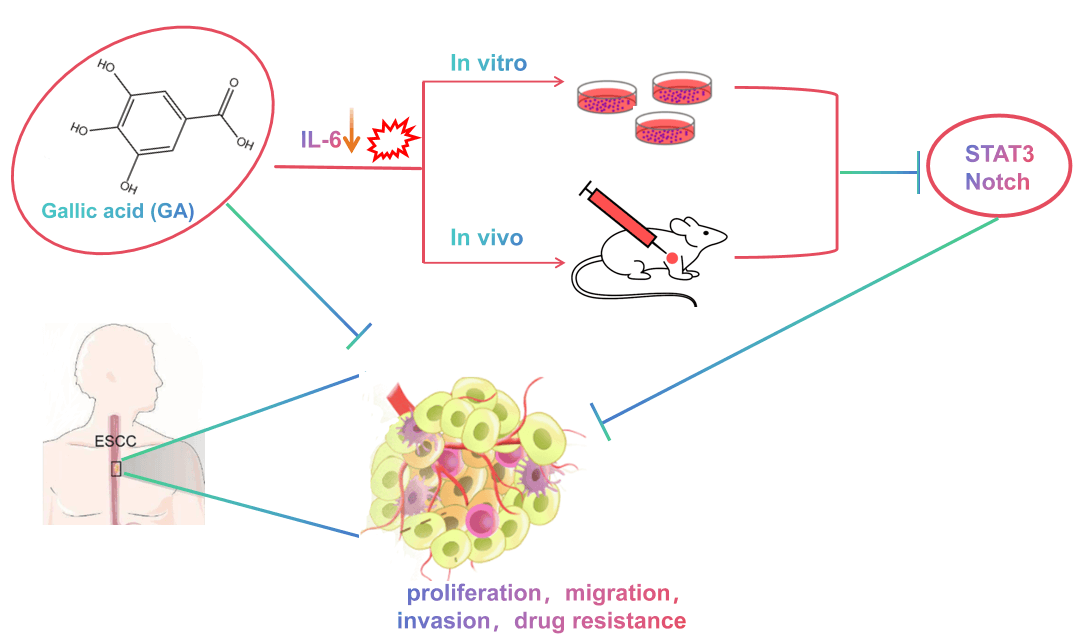
 Open Access
Open Access
ARTICLE
CHUCHU ZHANG1,#, YING LIU2,#, ZEHUI CHEN1, YI LIU3, QIYUAN MAO4, GE ZHANG5, HONGSHENG LIN4, JIABIN ZHENG6,*, HAIYAN LI1,*
Oncology Research, DOI:10.32604/or.2025.059290
(This article belongs to the Special Issue: Novel Biomarkers and Treatment Strategies in Solid Tumor Diagnosis, Progression, and Prognosis)
Abstract Objectives: Decades of clinical and fundamental research advancements in oncology have led to significant breakthroughs such as early screening, targeted therapies, and immunotherapy, contributing to reduced mortality rates in cancer patients. Despite these achievements, cancer continues to be a major public health challenge. This study employs bibliometric techniques to visually analyze the English literature on cancer prevention, screening, diagnosis, treatment, and rehabilitation. Methods: We systematically reviewed publications from 01 March 2014, to 01 March 2024, indexed in the Web of Science core collection. Tools such as VOSviewer Version 1.6.20 is characterized by its core idea… More >
Graphic Abstract
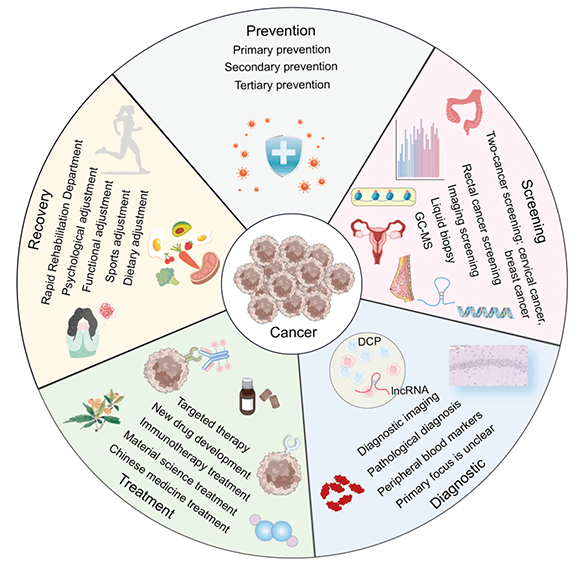
 Open Access
Open Access
ARTICLE
LINGJIE XU1, YIQIN XIA1, QIN QIN1, GUIQUN WANG1, KAI TAO2, WEI WEI1,*
Oncology Research, DOI:10.32604/or.2025.056176
(This article belongs to the Special Issue: Transcriptome Analysis in Tumor Microenvironment and Tumor Heterogeneity)
Abstract Background: The centrosome, a crucial cellular structure involved in the mitotic process of eukaryotic cells, plays a significant role in tumor progression by regulating the growth and differentiation of neoplastic cells. This makes the centrosome a promising target for therapeutic strategies in cancer treatment. Methods: Utilizing data from the TCGA database, we identified centrosome-related genes and constructed a prognostic model for 518 lung adenocarcinoma patients. Prognosis-associated genes were initially screened using univariate Cox regression, with overfitting minimized by applying LASSO regression to remove collinearity. Finally, a set of 12 genes was selected through multivariable Cox… More >
 Open Access
Open Access
ARTICLE
JIANMIAO YANG1,2,#, XIAOYAN SUN3,#, TIANTIAN WANG1, HAIQING ZHONG1,3, MIN HAN1,3, WUPING SHUAI4,5,6,*, DONGHANG XU1,*
Oncology Research, DOI:10.32604/or.2025.058997
(This article belongs to the Special Issue: Recent Advances in Cancer Pharmacology)
Abstract Objectives: Triphenylphosphine (TPP) and Doxorubicin (DOX) were conjugated to obtain Triphenylphosphine-Doxorubicin (TPP-DOX), which was applied in tumor cells for enhancement of DOX in mitochondria targeting. The study focused on investigating the anti-tumor effect of TPP-DOX in combination with radiotherapy throughout in vitro and in vivo studies. Methods: TPP-DOX was synthesized using the carbodiimide method. In vitro experiments were conducted with 4T1 cells (mouse breast cancer cell line) to assess apoptosis induction, mitochondrial targeting, reactive oxygen species (ROS) production, and mitochondrial membrane potential. The research evaluates the effects of TPP-DOX, DOX, and their combinations with radiotherapy. A nude mouse… More >
Graphic Abstract
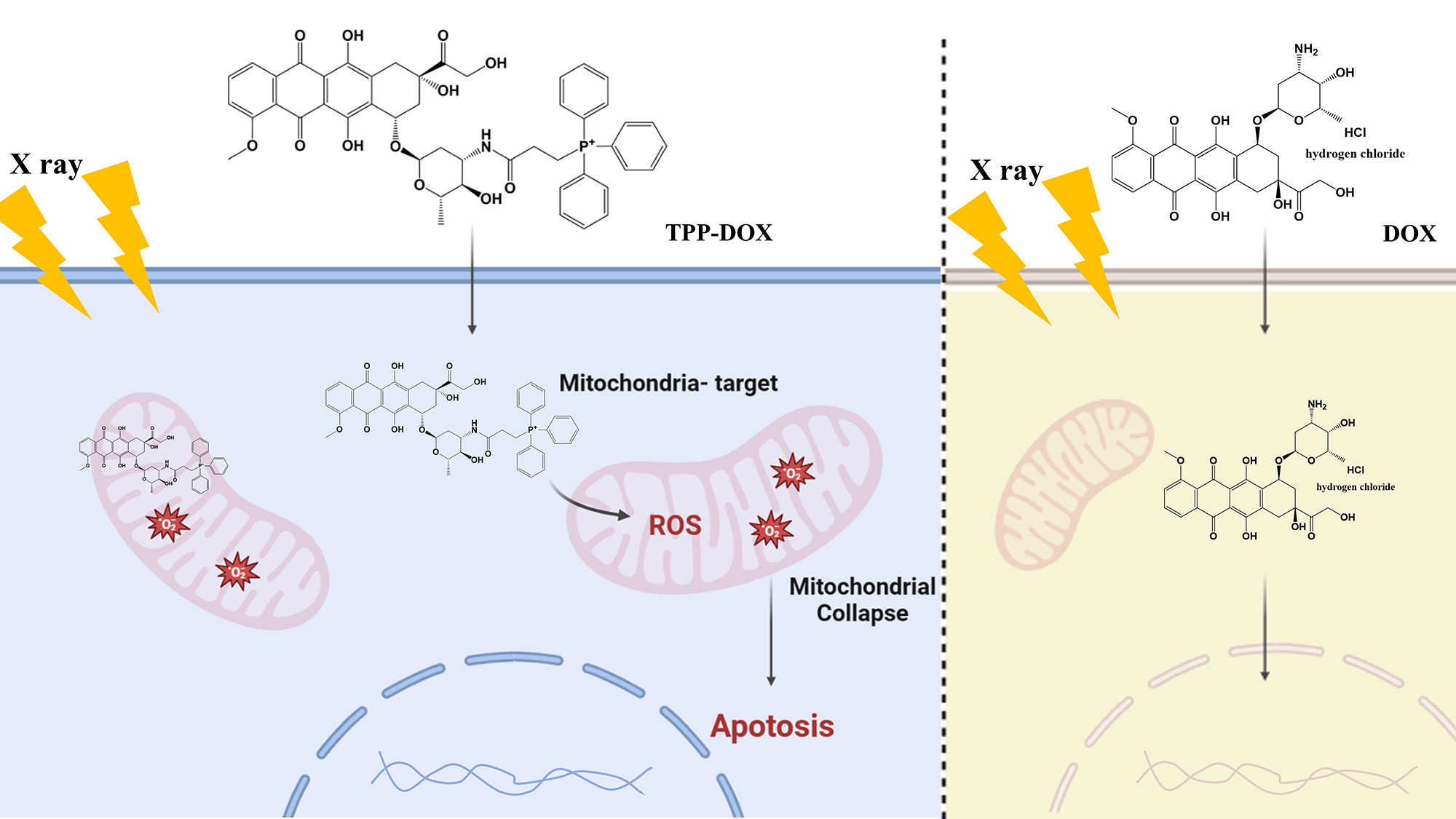
 Open Access
Open Access
REVIEW
YUZHENG LI1,2, LILI YU1, SHIYAO ZHOU1, HUA ZHOU2,3,*, QIBIAO WU1,2,*
Oncology Research, DOI:10.32604/or.2025.059311
(This article belongs to the Special Issue: Multi-Omics Approaches for Precision Medicine)
Abstract Background: Non-small cell lung cancer (NSCLC) involves complex alterations in the epidermal growth factor receptor (EGFR) signaling pathway. This study aims to integrate multimodal omics analyses to evaluate and enhance EGFR-targeted therapies. Methods: We reviewed and synthesized omics data—including genomics, transcriptomics, proteomics, epigenomics, and metabolomics data—related to the EGFR pathway in NSCLC, examined the clinical outcomes of current therapies and proposed new treatment strategies. Results: Integrated omics analyses revealed the multifaceted role of EGFR in NSCLC. Transcriptomic analysis revealed gene expression alterations due to EGFR mutations, with upregulation of oncogenes and downregulation of tumor suppressors. Proteomics More >
 Open Access
Open Access
REVIEW
YU HONG1,#, YUNXIANG TANG1,#, WENYAN ZHOU1, HANYUE LUO2, LINLIN BU2, HUI QIU3,*, QIUJI WU3,*
Oncology Research, DOI:10.32604/or.2025.059327
(This article belongs to the Special Issue: Novel Biomarkers and Treatment Strategies in Solid Tumor Diagnosis, Progression, and Prognosis)
Abstract As a rising immune checkpoint on tumor cells, CD24 is closely related to tumorigenesis and progression. CD24 can directly regulate the malignant behavior of tumor cells and indirectly inhibit the function of immune cells in the meantime, which promotes the immune escape of tumor cells, induces cancer invasion and causes poor prognosis. The basic principle of cancer treatment is to induce cell death and inhibit cell survival. Resistance to chemoradiotherapy is a critical challenge in oncology, which limits the effectiveness of anti-cancer treatments. Many studies have shown a strong association between CD24 and chemoradiotherapy resistance More >
 Open Access
Open Access
REVIEW
JIE ZHONG1, JUE LIU1, XING TANG2, WENCHAO ZHOU2, GUANGMING SONG1, YUHUAN ZENG1, XIAODI ZHANG1, JIANBIN ZHOU1, JieZhou1, LU CAO1, QUNFENG ZHANG1,*, YUKUN LI2,*
Oncology Research, DOI:10.32604/or.2025.058760
Abstract The cell cycle is a tightly coupled series of events that enable cells to grow and proliferate. Cyclin-dependent kinases (CDKs) play crucial roles in the cell cycle by enabling cells to transition between different phases when they are activated. Cell cycle proteins enhance the activity of CDKs, while natural CDK inhibitors (CDKIs) suppress them. The cell cycle continues in cycles under normal conditions, but when conditions change, cells halt or terminate the cell cycle. Tumors are tissues that grow out of control, and the mechanisms of various types of tumors are different; however, almost all… More >
Graphic Abstract
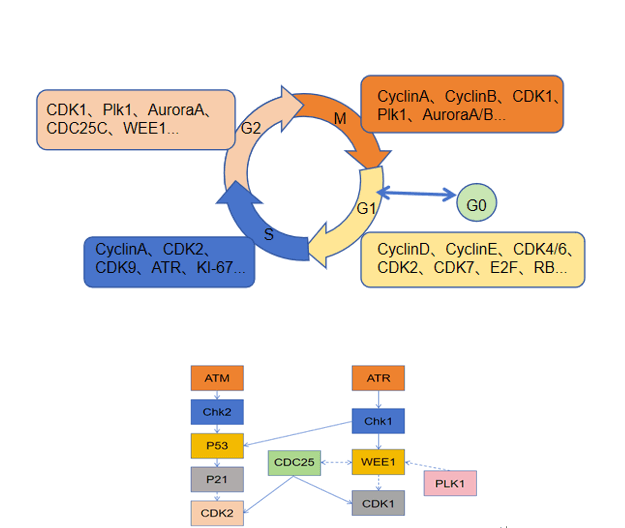
 Open Access
Open Access
REVIEW
JUNPING LIU1,2, FEIRAN GAO1, DANTING WANG2, RUIXUE ZHOU2, CHUNYAN HUANG2,*
Oncology Research, DOI:10.32604/or.2024.059113
Abstract Exosomes (EXOs) play an important role in the progression of breast cancer. EXOs, with a diameter of approximately 100 nm, have a simple structure but diverse functions, and can affect the development of breast cancer through signal transduction and molecular transfer, etc. Angiogenesis provides nutrients for the growth and metastasis of breast cancer and is a crucial part of tumor progression. The mechanism of tumor angiogenesis is complex. The VEGF/VEGFR pathway promotes angiogenesis by regulating the activities of ECs. Hypoxia, a common feature in the tumor microenvironment, as a key regulator, can affect angiogenesis in… More >
Graphic Abstract
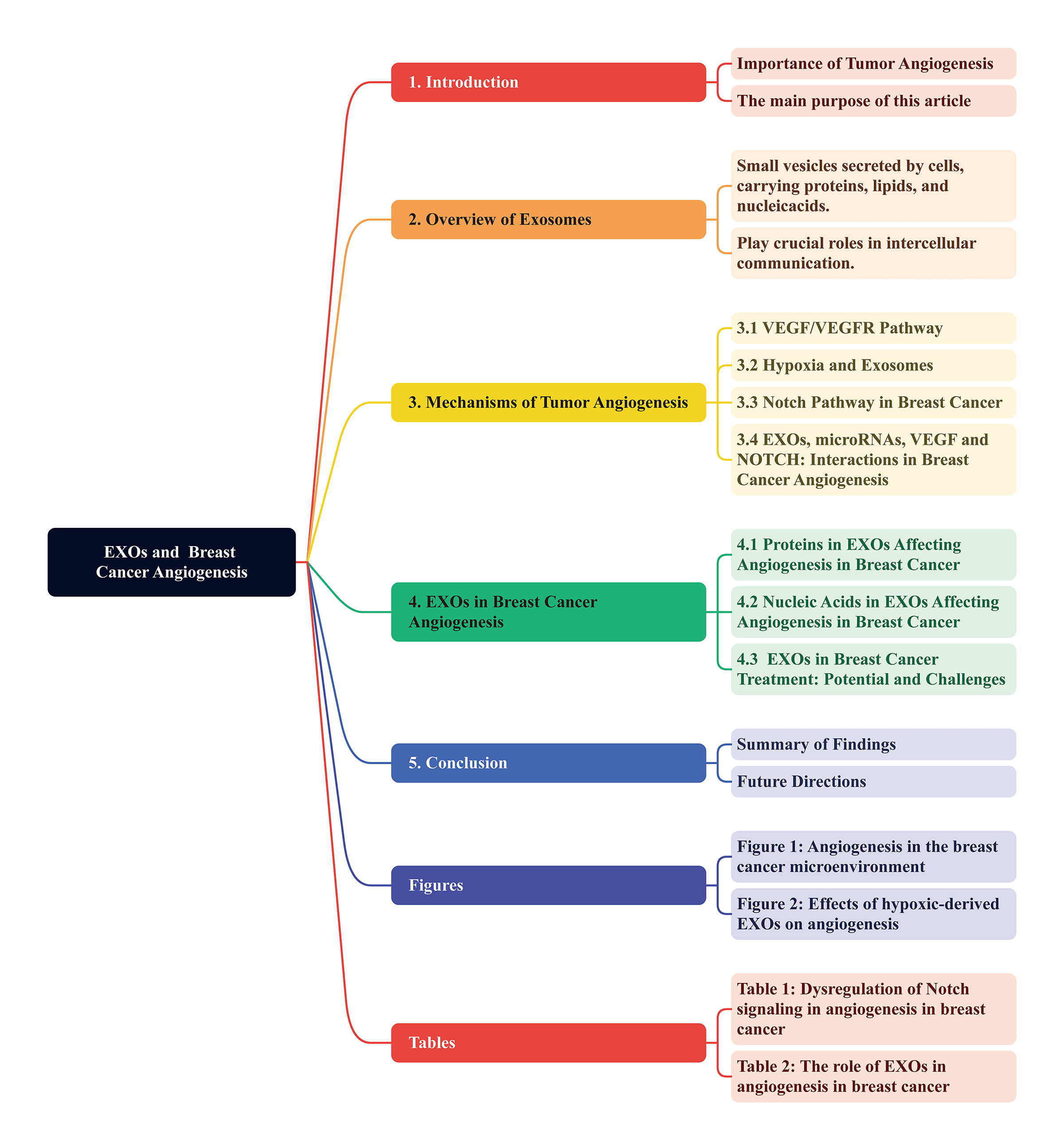
 Open Access
Open Access
ARTICLE
LIBO LIANG1, XINYI WANG2,3,4, YUPING ZENG2,3,4, HAO CHEN2,3,4, WEN ZHOU1, HONGYING MU2,3,4, GA LIAO5,6,*
Oncology Research, DOI:10.32604/or.2024.056708
Abstract Objectives: Exosomal long noncoding RNAs (lncRNAs) might facilitate epithelial–mesenchymal transition (EMT) in liver cancer after transarterial chemoembolization (TACE), thereby enhancing tumor cell invasiveness and migration. This study investigated the prognostic role of plasma exosomal long noncoding RNA-plasmacytoma variant translocation 1 (lncRNA-PVT1) in TACE treated hepatocellular carcinoma (HCC). Methods: Plasma exosomal lncRNA-PVT1 was evaluated via qPCR before and after TACE. Hepatoma cell behavior was investigated in different HCC cell lines. A lncRNA-PVT1 plasmid was synthesized and overexpressed, and si-lncRNA PVT1 was transfected into poorly invasive cells to reveal its influence on cell characteristics. The lncRNA-PVT1–FoxM1 interaction… More >
Graphic Abstract
